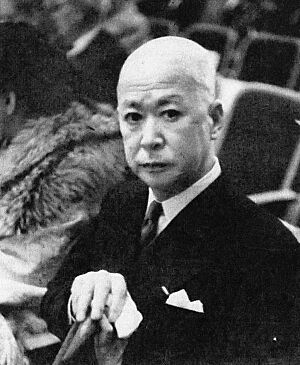Kōsaku Yamada facts for kids
Kōsaku Yamada (born June 9, 1886 – died December 29, 1965) was a very important Japanese composer and conductor. He helped bring Western classical music to Japan. He also wrote many famous Japanese songs and operas.
| Top - 0-9 A B C D E F G H I J K L M N O P Q R S T U V W X Y Z |
Life Story of Kōsaku Yamada
Kōsaku Yamada was born in Tokyo, Japan. He began his music studies at the Tokyo Music School in 1904. There, he learned from German composers like August Junker and Heinrich Werkmeister.
In 1910, Yamada traveled to Germany to continue his studies. He joined the Prussian Academy of Arts. He learned how to compose music from Max Bruch and Karl Leopold Wolf. He also studied piano with Carl August Heymann-Rheineck. He returned to Japan in late 1913.
Yamada also visited the United States in 1918 for two years. While in New York City, he led a special orchestra. This orchestra was made up of musicians from the New York Philharmonic and New York Symphony.
Yamada passed away in Tokyo on December 29, 1965, from a heart attack.
Yamada's Amazing Music
Kōsaku Yamada wrote about 1,600 pieces of music! This includes around 700 art songs, which are like short musical poems.
First Japanese Symphony
Yamada wrote the first complete symphony in Japan. It was called Symphony in F major, "Triumph and Peace" (1912). A symphony is a long piece of music for an orchestra, usually with four parts called movements.
The beginning of this symphony has a special tune. It uses notes like G-A-D-E, which is a pentatonic scale. This scale is similar to the one used in the Japanese national anthem.
Blending Japanese and Western Sounds
Yamada also wrote a piece called Sinfonia "Inno Meiji" (1921). In this work, he used traditional Japanese instruments. One instrument was the hichiriki, an ancient Japanese wind instrument. This showed how he liked to mix Japanese and Western music styles.
Famous Songs and Operas
One of his most famous songs is "Akatombo" (Red Dragonfly), written in 1927. Many famous singers have performed and recorded his songs.
Yamada also composed operas. An opera is a play where the story is told mostly through singing. His opera Kurofune (Black Ships) is considered one of Japan's most famous operas. His music was even featured at the art competition at the 1936 Summer Olympics.
Yamada as a Conductor
Besides composing, Yamada was also a talented conductor. A conductor leads an orchestra. He worked hard to introduce Western orchestral music to Japan.
He was the first to perform many famous Western pieces in Japan, including:
- Debussy's Prélude à l'après-midi d'un faune
- Dvořák's Symphony No. 9
- Gershwin's An American in Paris
- Sibelius' Finlandia
- Shostakovich's Symphony No. 1
- Johann Strauss II's An der schönen blauen Donau
In 1940, a piece called Ouverture de fête by Jacques Ibert was dedicated to Japan. Yamada was the conductor for its very first performance.
Important Compositions
Here are some of Kōsaku Yamada's most important musical works:
Operas
- Ayame [Iris] (1931)
- Kurofune [Black Ships] (1940)
Orchestral Works
- Symphony in F major "Triumph and Peace" (1912)
- Sinfonia "Inno Meiji" (1921)
- Nagauta Symphony "Tsurukame" (1934)
Songs
- "Karatachi no hana"
- "Pechika"
- "Kono michi" [This Road]
- "Akatombo" [Red Dragonfly] (1927)
Images for kids



